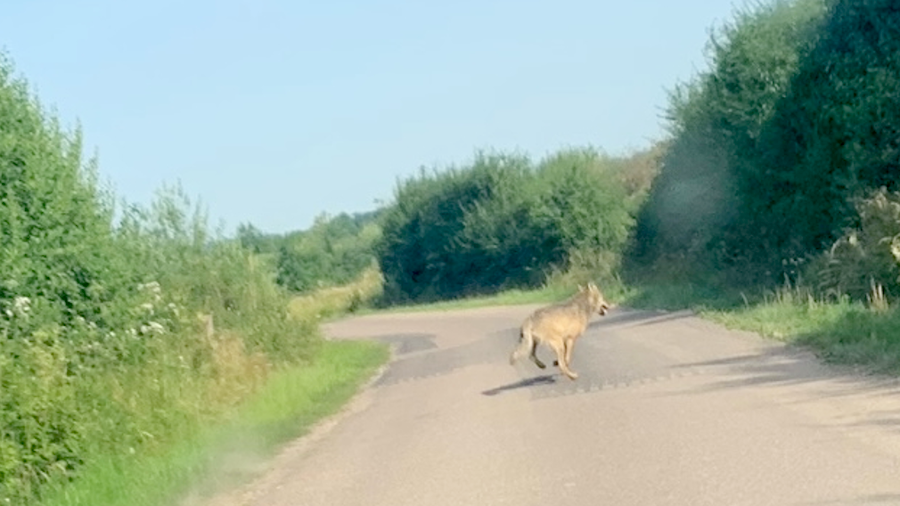One of the longest dispersal movements carried out by a wolf registered
A Canis lupus specimen has traveled 1,240 kilometers from Nordhorn, Germany, where it was born in 2020, to Vilaller, in the mountains of the Alta Ribagorça region, in February 2023, passing through France in 2022. The comparison of samples in genetic laboratories, including the Veterinary Service of Molecular Genetics of the Universitat Autònoma de Barcelona (UAB), has made it possible to follow the route of this animal.

The cooperation between Germany, France and Catalonia has made it possible to document in Europe one of the longest dispersal movements ever made in the world by a wolf (Canis lupus), thanks to the monitoring of the species on the ground and also in the col ·collaboration between genetic laboratories of the three territories.
Specifically, the monitoring of the wolf through molecular genetics implemented in Germany, France and Catalonia, as well as the scientific collaboration between three laboratories, among them the Molecular Genetics Veterinary Service of the Universitat Autònoma de Barcelona, has made it possible to discover that a llopha individual traveled 1,240 km between the place of his birth near Nordhorn (Alamanya) in 2020 and the municipality of Vilaller (Alta Ribagorça), where he was last detected in February 2023, through France in May 2022.
This is the largest dispersal event of a gray wolf ever documented worldwide. Previously, the longest recorded straight-line distances involved 1,092 km between Norway and Finland (Wabakken et al., 2007), 880 km between Germany and Belarus in 2009 (Reinhardt und Kluth, 2016), and 829 km between Switzerland and Slovakia in 2022-2023 (KORA).
The find arises following the location a year ago of a faeces found by the Special Canine Group (GEK9) of Rural Agents in the framework of the monitoring of the wolf carried out by the operative body and coordinated by the agent Gabriel Lampreave, together with the Department of Climate Action, Food and Rural Agenda.
In particular, wolf excrement was detected on February 13, 2023 in Alta Ribagorça thanks to the use of specially trained dogs from the Special Canine Group (GEK9) to identify feces of large carnivores.
In this area there has been a male identified since 2021, but automatic photographs during the winter of 2022-2023 provided elements that made us suspect the presence of a possible second specimen. For this reason, the prospecting effort was increased, which allowed the collection of a sample on the southern slope of the Pyrenees, in the municipality of Vilaller. The genetic analysis carried out by the laboratory of the Universitat Autònoma de Barcelona (UAB) indicated a lineage "w1" referred to the population of wolves in Central and Eastern Europe, which was the first case of detection of this type in the 'Spanish state.
As part of a long-standing collaboration between France and Catalonia in the matter of wolf monitoring, a sample was sent for analysis to the French laboratory Antagene, which confirmed the coincidence with an individual previously located in the region of Burgundy, in the east of France. Specifically, it was the individual called by scientists GW1909m, which had also previously been located in Germany.
Since February 2023, no evidence of the presence of this individual has been located in Alta Ribagorça.
The tour through France and Germany
The same wolf detected in Catalonia was already located on June 17, 2022, when a driver saw a canine running along a road in the commune of Fleurey-Les-Faverney (Haute Saone, France). He identified it as a wolf-like canid, managed to take a photo and alerted local authorities. Thanks to this warning, an officer from the French Biodiversity Agency (OFB), a member of the species monitoring network in France, managed to collect some hairs in a wire fence in the place where the witness indicated that he had past the wolf These hairs were subjected to genetic analysis. The reference laboratory Antagene, responsible for carrying out genetic analyzes of wolves in France, found the DNA haplotype called "w1", which is quite unusual for wolves in France.
Because this individual carried a genetic trait that occurs frequently in Germany and adjacent areas of central and northeastern Europe, a sample was sent for cross-analysis to the German reference laboratory. Cross-validation revealed that this sample perfectly matched a male named GW1909m by the scientists, already known in the German genetic database.
Thanks to faecal samples analyzed there in August 2020 by the Senkerberg Research Institute, GW1909m is known to be born in a cluster located near Nordhorn (Lower Saxony), a few kilometers from the border with the Netherlands. The analysis allowed this individual to be assigned to its birth group, where it was detected again in May 2021. Genetic evidence shows that GW1909m must have been born in the spring of 2020, as its parental group did not play before this year.
The dispersal capacity of the wolf
Wolves (Canis lupus) are spreading across Europe thanks to strict legal protection since the late 1970s. Recolonization of new areas has occurred from Italy to the Alps and also from central Europe to in the plains of Germany or western Poland.
The species is known for its plasticity